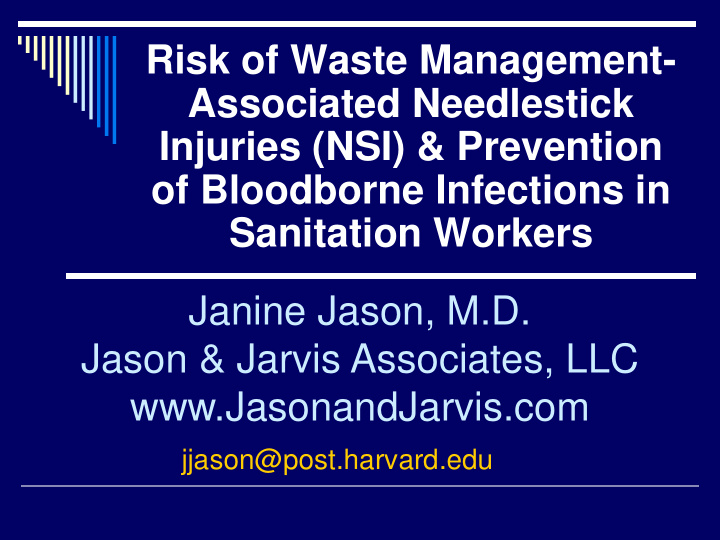



Risk of Waste Management- Associated Needlestick Injuries (NSI) & Prevention of Bloodborne Infections in Sanitation Workers Janine Jason, M.D. Jason & Jarvis Associates, LLC www.JasonandJarvis.com jjason@post.harvard.edu
Number (in Millions) of U.S. Persons with Diagnosed Diabetes, 1980 – 2011 From: CDC’s Diabetes Program -Data and Trends http://www.cdc.gov/diabetes/statistics/prev/national/figpersons.htm
Evidence that Increasing Insulin Use Hasn’t Been Associated with an Increase in Non-Healthcare-Setting Occupational Accidental NSI No analyzable data in NHIS and the Survey of Occupational Injuries and Illnesses (SOII) A NIOSH study had to expand its survey time frame in order to collect a minimally adequate number of non-hospital, work- related injuries for analysis.
Evidence that Increasing Insulin Use Hasn’t Been Associated with an Increase in Non-Healthcare-Setting Occupational Accidental NSI In NHAMCS, NAMCS, & NEISS, the numbers of community-acquired and work-related accidental needlestick/sharp injuries are not large and do not appear to be increasing.
Number of CANSI Treated in U.S. Emergency Departments, by Year, 2001-2008, NEISS-AIP 4500 4000 NSt=CV>30% 3500 3000 NSt 2500 2000 NSt 1500 1000 500 0 From: Jason, 2000 2002 2004 2006 2008 2013
Total Number of Documented Reports of HBV, HCV, or HIV Transmission from Non- healthcare-associated Accidental NSI Pathogen Number Worldwide U.S. HBV 3 0 HCV 3 0 HIV 0 0
Why Are Infections from Non-Healthcare-Associated NSI So Rare?
HBV, HCV, and HIV Infection and U.S. Sanitation Workers Like all U.S. citizens, a sanitation worker can be infected with any of these viruses and not necessarily know it. This is the case, whether or not the worker has had a NSI.
How Employers Could Deal with Employees’ Perceived Risk of Infection from a NSI Educate employees concerning the real level of risk associated with NSI. In practical ways, demonstrate concern and commitment to employees’ health and to decreasing employees’ actual heath risks.
Addressing Concerns About Waste Management-Associated NSI Waste management employers could: Sponsor an independent prospective study of NSI and other sharp injuries occurring in their employee population. Educate employees concerning the study results and provide accurate information on the actual risks associated with NSI.
Addressing Sanitation Workers’ Risks of Bloodborne Infections Aside from the issue of NSI, sanitation/waste management employers could provide, at no cost, to all employees: HBV, HCV, and HIV testing Diphtheria-tetanus boosters, as needed HBV vaccination
Determinants of the Risk of Infection from a NSI Viability of contaminating organisms Inoculum and infectivity Invasiveness of the injury Likelihood that source is infected Immune status of host Receipt or non-receipt of appropriate PEP
Determinants of the Risk of Infection from NSI Viability of contaminating organisms Inoculum and infectivity Invasiveness of the injury Likelihood that source is infected Immune status of host Receipt or non-receipt of appropriate PEP
Survival of HCV In a Low Void Volume (Insulin) Syringe From: Paintsil, 2010
Determinants of the Risk of Infection from NSI Viability of contaminating organisms Inoculum and infectivity Invasiveness of the injury Likelihood that source is infected Immune status of host Receipt or non-receipt of appropriate PEP
Rates of Transmission from NSI Involving a Known Positive Source: HBV, HCV, and HIV HBV To a non-immunized host: ~23%-62% (Reduced with PEP) To an immune host: 0% HCV: ~1.8% (range: 0% – 10%) HIV: ~0.2-0.5% (Varies with exposure parameters and reduced with PEP)
Determinants of the Risk of Infection from NSI Viability of contaminating organisms Inoculum and infectivity Invasiveness of the injury Likelihood that source is infected Immune status of host Receipt or non-receipt of appropriate PEP
Healthcare-associated NSI: Historic Perspective Jagger et al., 1988: NSI in personnel at U VA, 326 injuries over a 10-month period Disposable syringes accounted for highest proportion (35%) but lowest rate (6.9/100,000 syringes) of injuries Devices requiring disassembly had up to 5.3 X the rate for disposable syringes 1/3 of injuries were related to recapping
What to Consider in Determining the Risk of Infection from a NSI What type and gauge was the needle? Had the needle entered a patient’s vasculature? Does the needle/syringe have visible blood? How deep was the puncture wound and was it into a blood vessel? If the needle had been discarded, was the blood dry?
Determinants of the Risk of Infection from NSI Viability of contaminating organisms Inoculum and infectivity Invasiveness of the injury Likelihood that source is infected Immune status of host Receipt or non-receipt of appropriate PEP
HBV Vaccine and U.S. Sanitation Workers HBV vaccine prevents HBV infection and is available to all U.S. citizens. HCWs provide an example of the effectiveness of HBV vaccine In 1983, before vaccine : > 10,000 HCW cases In 2001: <400 occupational cases This represents a 95% decrease, even though an estimated 73,000 people in U.S. were infected
Incidence of Acute HBV, per 100,000 U.S. Population, 1982-2006 HBV vaccine becomes available in U.S. CDC, 2009
Ongoing Revolutionary Changes in HCV Therapy An estimated 3-4 million U.S. persons are chronically infected with HCV. Around half are unaware of their status. New direct-acting oral agents capable of curing hepatitis C virus (HCV) infection are being approved for use in the United States. These changes offer the potential of a cure for most U.S. patients within the next decade.
HIV in the U.S. An estimated 1,2 million Americans are living with HIV. Of these, approximately 240,000 are unaware of their HIV-positive status. HIV is currently not curable but it is treatable.
HBV, HCV, and HIV Infection and U.S. Sanitation Workers HCV testing is recommended for all U.S. citizens born between 1945-1965 and is available to everyone. The U.S. Preventive Services Task Force recommends that clinicians screen all persons aged 15 – 65 years for HIV infection at least once, regardless of their risk .
Determinants of the Risk of Infection from NSI Viability of contaminating organisms Inoculum and infectivity Invasiveness of the injury Likelihood that source is infected Immune status of host Receipt or non-receipt of appropriate PEP
What to Consider in Determining an Sanitation Worker’s Infection Risk from a NSI Has the worker received HBV vaccine? Has the worker been previously infected with HBV, HCV, &/or HIV?
Recommend
More recommend